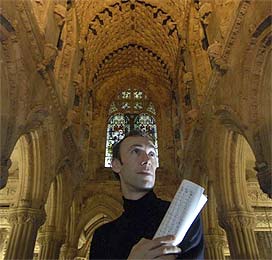October 1, 2005
A code cracked
I have not yet read the book The Da Vinci Code but it has generated a lot of interest in the ceiling of Rosslyn Chapel. It seems that the code has been cracked. The Scotsman has the story:Composer cracks Rosslyn's musical codeIt will be interesting to see the reaction from this as well as to see the final version of his proof. It might also be fun if there were two or more messages encrypted -- an architect is by nature a mathematician and being able to place a broad message and a subtle message in the same context is not impossible. Also, maybe the music was a favorite tune of one of the patrons of the Chapel.
A musical code hidden in mystical symbols carved into the stone ceiling of Rosslyn Chapel has been unravelled for the first time in more than 500 years.
Scottish composer Stuart Mitchell took 20 years to crack a complex series of codes, which have mystified historians for generations. His feat was hailed by experts as a stroke of genius.
The codes were hidden in 213 cubes in the ceiling of the chapel, where parts of the film of Dan Brown's best-seller The Da Vinci Code were shot this week.
Each cube contained different patterns to form an unusual 6½-minute piece of music for 13 medieval players. The unusual sound is thought to have been of great spiritual significance to those who built the chapel.
The melody was unravelled after Mr Mitchell discovered the stones at the bottom of each of 12 pillars inside the Midlothian chapel formed a cadence (three chords at the end of a piece of music) of which there were only three types in the 15th century.
Mr Mitchell, 40, who has been nominated for the British Composer Awards 2005, said the music sounded like a nursery rhyme. "Everyone wants to hear something miraculous but William Sinclair, who designed the chapel, was an architect, not a musician," he said. "It is evident from the nursery rhyme style of the music that he could not play very well.
"It is in triple time, sounds childlike and is based on plain chant which was the common form of rhythm of the time. In the 1400s, there wasn't a great deal of guidance for tempo so I have chosen to make it run for six and a half minutes but it could be stretched to eight minutes if a different tempo was used.
"At the end of each pillar there is a musician playing a different medieval instrument so over the next few months I will be working on obtaining these instruments so we can record the piece as it was meant to be heard."
The Edinburgh musician, who has named the piece The Rosslyn Canon of Proportions, added: "There are a great deal of layers but I can't give it all away. I took photographs of the cubes and broke them down into sections. I found a lot of symbolism and decoys to throw people off. The key was recognising the cadences and that each arch was the music for a different musician."
The strange combination of instruments in the piece includes bagpipes, whistles, trumpet, a medieval mouth piano, guitar and singers.
The music covers two pages of manuscript but Mr Mitchell has given a sneak preview of five bars.
James Cunningham, author of The Medieval Diatonic Scale, has seen Mr Mitchell's manuscripts from the chapel. He said: "I believe this is an excellent interpretation of the symbolism of the stone arches in Rosslyn Chapel. It is a stroke of genius to have discovered the cadences which inspired the music.
"Although many people have attempted to decode the cubes, Mr Mitchell has proved that a musician was what was needed here rather than a historian or architect."
Stewart Beattie, of the Rosslyn Trust, said he looked forward to hearing the work. "We are always interested in information which moves the chapel forward in terms of discovering its codes.
"However Rosslyn Chapel has been provoking people for the last 500 years and I'm sure it will continue to fulfil its function by remaining enigmatic."
Visitors have flocked to the 15th-century chapel since The Da Vinci Code, which has sold 17 million copies worldwide, fuelled speculation that it was erected to house the Holy Grail.

Stuart Mitchell in Rosslyn Chapel under the stone ceiling cubes which he discovered encoded the notes of a piece of medieval music.
Comments
Post a comment